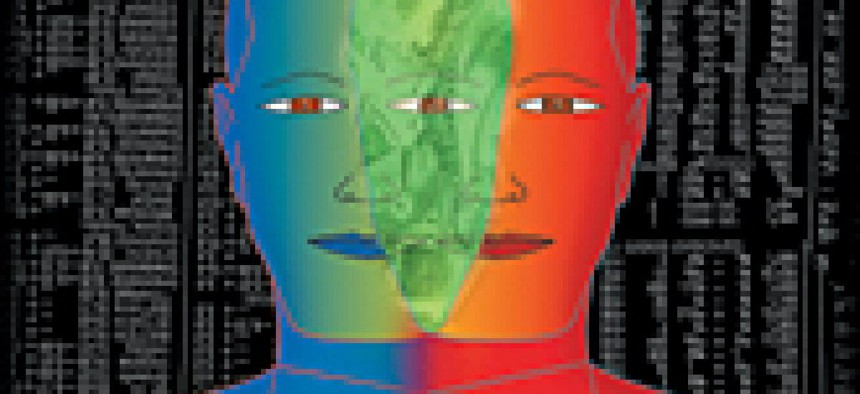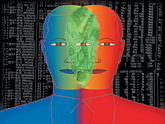Security as Plain as the Nose on Your Face

Sandy Ferris, a forensic technician with the North Vancouver detachment of the Royal Canadian Mounted Police, was using a facial recognition system to identify an offender when she made a startling discovery.
Sandy Ferris, a forensic technician with the North Vancouver detachment of the Royal Canadian Mounted Police, was using a facial recognition system to identify an offender when she made a startling discovery. Ferris was running the suspect's image against a database of more than 8,000 offenders that was part of a computerized arrest and booking system installed by Imagis Technologies Inc. Imagis' facial scan system, known as ID-2000, not only identified the suspect, but showed he was in the database under three additional aliases."We found out we were dealing with a single criminal, not four," said Ferris, whose department has been using the ID-2000 system since February 2000.The ability to identify offenders and uncover aliases is one of several ways state and local governments have come to rely on facial recognition software in recent years. The early adoption of facial recognition solutions by law enforcement agencies and motor vehicle departments has laid the groundwork for what the software makers hope will be a wealth of new business opportunities in the aftermath of the Sept. 11 attacks on New York and Washington."We're seeing the tip of the iceberg," said Jerry Janik, president of AcSys Biometrics Corp., Burlington, Ontario, referring to the future of biometric solutions, such as facial recognition. Janik said after Sept. 11, the sales cycle for his company went "from two or three years to tomorrow."Imagis President Iain Drummond said he has received many new inquiries about his product after Sept. 11, and nine of every 10 calls are coming from the United States. Up until the terrorist attacks, facial scanning for surveillance drew controversy like a magnet. In one widely publicized case, privacy advocates voiced strong concerns when Visionics Corp. of Jersey City, N.J., deployed its FaceIt system on 36 cameras in Tampa, Fla., at the request of local police to scan the crowds for suspected criminals. But resistance to the technology, which the companies tout as nonintrusive, is expected to fade as the public becomes accustomed to stronger security measures following the attacks."There is a mind-set that we shouldn't do it because it infringes on privacy, but in the long run we will deploy these technologies as necessary," said Rob Atkinson, director of the New Economy and Technology Project at the Progressive Policy Institute, Washington.Facial scanning is a form of biometrics, the study of measurable biological characteristics such as eyes, faces, fingerprints and speech. Facial scanning accounts for about 15 percent of the market share of all biometric applications.Facial scanning provides verification and identification. It can control access to computer systems by verifying the user, or it can identify a suspected criminal or terrorist by searching a database containing thousands of faces.Revenue from biometrics is expected to grow rapidly from $523 million in 2001 to $1.9 billion in 2005, according to the International Biometric Group, a New-York based integration and consulting firm.Even before the attacks, leading systems integrators, such as Bull Information Systems Inc., Billerica, Mass.; DynCorp, Reston, Va.; Electronic Data Systems Corp., Plano, Texas; Logicon Inc., Herndon, Va.; Maximus Inc., Reston, Va.; and Unisys Corp., Blue Bell, Pa., were exploring how they might integrate facial scanning into their government offerings.Following the attacks, integrators will be looking not only at traditional applications of facial recognition technology for law enforcement and criminal justice, but also at creative ways it might be applied to sectors where it has not been used before, such as health and human services, said analysts and industry officials. For example, integrators helping government agencies comply with the security and privacy requirements of the Health Insurance Portability and Accountability Act may want to use facial recognition software to control who has access to medical records, Janik said.HIPAA offers "a tremendous opportunity" for biometric applications, said Gary Glickman, a business development manager with Maximus. In addition to security, biometrics offers more convenience for users, he said. Instead of having to remember multiple personal identification numbers, an agency user can simply log on with a fingerprint or, in the case of facial recognition, by facing the monitor."No matter how [agencies] manage their data, we can provide the security side and go right on top of what they're using," Janik said.AcSys, which provides face and speech recognition, is a joint venture between Nexus Group International Inc. and Artificial Neural Devices Corp., both of Burlington, Ontario. The 1-year-old company hopes to grow its business by tapping into the large customer base of integrators, Janik said. For this purpose, AcSys teamed in August with Engineering Systems Solutions Inc. of Frederick, Md., and DynCorp to bring its facial recognition system to the U.S. intelligence community. ESS is the prime contractor on a team that has installed a facial recognition demonstration project to control entry into a security office at an intelligence facility; DynCorp is the integrator responsible for installation testing and operation. Janik declined to name the agency. Imagis has installations of its biometric facial technology at Toronto's Pearson Airport and at various police departments in California, Mexico and western Canada. Most of the California projects are with police departments surrounding Los Angeles and San Francisco. "We've had a number of early successes," Drummond said.As for alliances, the company signed an agreement in 2000 that allows Bull Information Systems to market its products and solutions in the United Kingdom. Visionics has a number of motor vehicle and law enforcement contracts around the country for its FaceIt system. Frances Zelazny, a company spokeswoman, said a number of other cities are interested in deploying FaceIt for urban surveillance similar to how the system is being used in Tampa. The company expects to sign contracts with other municipalities within the next year, she said.In addition to the Tampa project, Visionics has other high-profile deployments at Iceland's Keflavik Airport as well as the cities of Birmingham and London in the United Kingdom. Zelazny said that while Visionics partners frequently with large systems integrators, its only formal partnership at the moment is with EDS. The two companies have cooperated on providing security solutions for international border crossings, she said. Viisage Technology Inc. of Littleton, Mass., has contracts in 15 states, Viisage President Tom Colatosti told Washington Technology earlier this year. In the state and local market, Colatosti said the company had leveraged its driver's licensing applications into applications for criminal justice and social services. Viisage could not be reached for this article. Security experts warn that facial scanning is not a panacea for Internet security or protection against criminals or terrorists. Indeed, they are urging agencies and departments at all levels of government to deploy the technology gradually and to allow it to reach full maturity."It's proven for 1-1 matches, but we're uncertain how it will work on a 1-to-many basis," Atkinson said. As time elapses, "systems will improve and have fewer false positives," he said. Facial scanning is not completely effective at identifying individuals in crowds, it is not immune to adverse photographic conditions, and it cannot always adjust to subject appearance over time, according to the IBG. Facial scanning is not as reliable as, for example, fingerprinting or iris scanning, said Michael Thieme, an IBG senior consultant. "It's not going to redefine criminal justice, and it won't replace fingerprinting," he said.Still, using facial scanning in public places could significantly deter criminal and terrorist activity, Thieme said. "It's useful when used as a deterrence," he said. "But it's not helpful if it is not advertised that it is being used."XXXSPLITXXX- Burlington, Ontario Jerry Janik Neural technology applications for the financial, government, manufacturing, security and business sectors 2000 30 $5 million Vancouver, British Columbia Ian Drummond Biometric-based software applications for law enforcement, airport and security industries 1987 25 $4 million Littleton, Mass. Tom Colatosti Internet, electronic and physical access control, real-time image identification and verification, voter registration, national IDs and law enforcement and social services 1996 100 $28 million Jersey City, N.J. Joseph Atick Enabling technology, platforms, products and systems for biometric identification, with a special focus on face recognition and fingerprint identification 1994 200 $30 million

AcSys Biometrics Corp.
Location:
President:
Business:
Founded:
Employees:
Annual Revenue:
Imagis Technologies Inc.
Location:
President:
Business:
Founded:
Employees:
Annual Revenue:
Viisage Technology Inc.
Location:
President:
Business:
Founded:
Employees:
Annual Revenue:
Visionics Corp.
Location:
Chairman and CEO:
Business:
Founded:
Employees:
Annual Revenue:

Privacy Concerns Fade, Demand Rises for Facial Recognition Technology
AcSys Biometrics Corp.
Location:
President:
Business:
Founded:
Employees:
Annual Revenue:
Imagis Technologies Inc.
Location:
President:
Business:
Founded:
Employees:
Annual Revenue:
Viisage Technology Inc.
Location:
President:
Business:
Founded:
Employees:
Annual Revenue:
Visionics Corp.
Location:
Chairman and CEO:
Business:
Founded:
Employees:
Annual Revenue:

